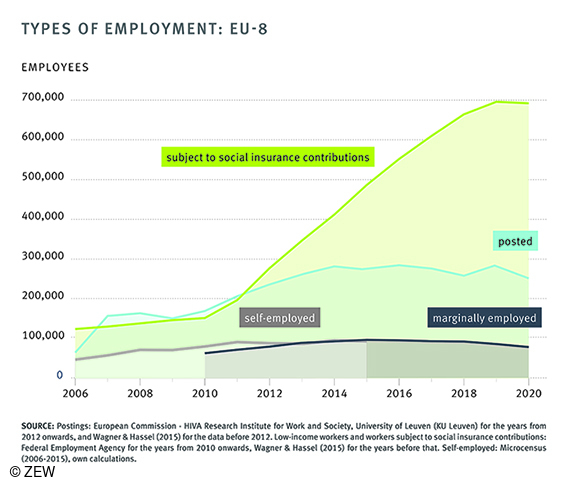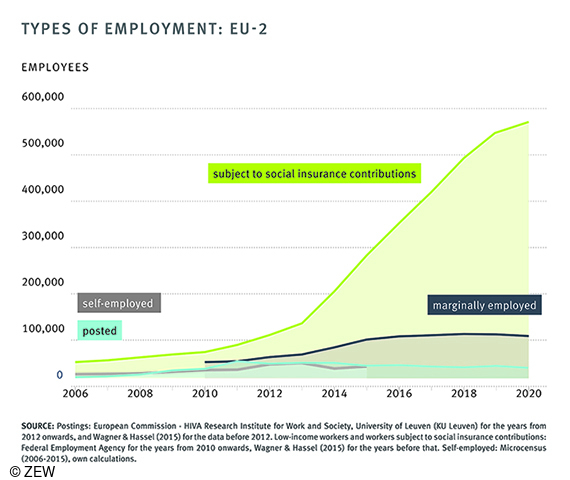Eastern Europeans Relieve the Tight German Labour Market
ResearchGermany heavily depends on workers from other EU countries. As a result of the EU’s free movement of workers, the number of immigrant workers has more than quadrupled: in 2020, 1.3 million Eastern Europeans were working in Germany subject to social insurance contributions. Mainly, they worked in the postal and warehousing sectors, as drivers and in cleaning. Most of them pay into the German social security system, while employment as mini-jobbers and postings play an increasingly minor role among Eastern Europeans. In addition, Eastern Europeans work disproportionately often in occupational fields with a shortage of skilled workers, which is why they tend to contribute to relieving the tight German labour market. This is the result of a recent expert brief by ZEW Mannheim, which looks at the consequences of the free movement of workers from Central and Eastern Europe for the German labour market.
Since the free movement of workers from the new EU Member States came into effect in 2011, there has been a strong increase in the number of people from these countries taking up employment in Germany that is subject to social insurance contributions. Overall, the proportion of foreign employees subject to social insurance contributions grew to 12.9 per cent in 2020. On average, just under 107,000 people from the so-called EU-8 and EU-2 countries came to Germany each year. These are Poland, Estonia, Latvia, Lithuania, Slovakia, Slovenia, the Czech Republic and Hungary (EU-8), plus Romania and Bulgaria (EU-2). Overall, more and more Eastern Europeans came to Germany after the EU eastward enlargements, with a peak of around 1.3 million employees in 2020. “The employment growth is strongly driven by employees from Eastern Europe who are subject to full social security contributions, and not by mini-jobbers. Eastern Europeans therefore pay into the German social security system and acquire corresponding entitlements,” says Dr. Katrin Sommerfeld, head of the ZEW Junior Research Group “Integration of Migrants and Attitudes towards the Welfare State (IMES)” and co-author. Other forms of employment such as postings, marginal employment and self-employment have stagnated at a significantly lower level for years. The share of mini-jobbers fell from almost a quarter to only eight per cent (EU-8) and nine per cent (EU-2) – corresponding to around 90,000 employees – in recent years. For the EU-8 countries, postings are the second most important form of employment, which has levelled off at around 250,000 postings since 2011.
Eastern Europeans work disproportionately often in occupational fields with shortages of skilled workers
A look at the occupational fields in which Eastern Europeans are currently employed also confirms this finding: the employment of EU-8 and EU-2 nationals is highest in the postal and warehousing industry (170,000). This is followed by occupations as drivers in road transport (107,000), as well as in cleaning (102,000). The largest share of Eastern Europeans in an occupational field is in cleaning (36 per cent), food and beverage production (33 per cent), and building construction (32 per cent). “Such occupations in particular are characterised by low requirements for language skills or other non-routine interactive tasks. Many of the employees from the EU-8 and EU-2 work as skilled workers, but below their qualification level. For the future, it is therefore necessary to make even better use of immigrants’ skills than before. Therefore, political efforts should aim at opening up appropriate career paths,” says Katia Gallegos Torres, a researcher in ZEW’s Junior Research Group “Integration of Migrants and Attitudes towards the Welfare State (IMES)” and co-author.
In addition, compared to Germans, employees from the new EU countries work disproportionately often in occupational fields where there are shortages of skilled workers. According to the analysis, six of the top 15 occupational fields in which Eastern Europeans are most frequently employed lack skilled workers. These include nursing and geriatric care, metal construction and agriculture. 43 per cent of EU employees work in occupations with skilled labour shortages, while this is only true for about 32 per cent of Germans. “Overall, however, immigration to date has not been sufficient to compensate for the existing shortages of skilled workers and those expected in the future. Whether other migrant groups, such as asylum seekers or the recent influx of Ukrainian refugees, will be able to contribute to eliminating the shortages in the occupations mentioned is still unclear,” says Katrin Sommerfeld.



